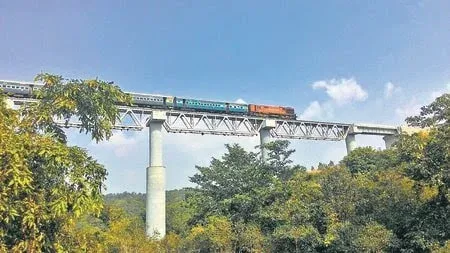( )
)
Economy of Jharkhand
M.L Singh*
Agriculture in Jharkhand depends largely on rainfall, 82% of which is received during four
months from June to September. The State is a mono- cropped region. Farming activities are
confined largely during the Kharif season from June to November-December. After kharif
season, a very small portion of net sown area( 17%) is brought under rabi crops. Jharkhand
is a food deficit State to the extent of 52% in case of food grains. The purpose of present
paper is to explain the nature and causes of agricultural backwardness in Jharkhand State.
Keywords : Jharkhand, Agriculture
Introduction
The State of Jharkhand was formed by carving out Chotanangpur and Santhal Pargana regions
from Bihar on 14th Nov’2000. Before the formation of State, these regions remained backward
due to neglect of public investment in agriculture and rural infrastructure and suffered from some
sort of colonial exploitation by mainstream population of Bihar. However, it is a great tragedy that 
even nine years after its formation the economic conditions of people in the state have remained
unchanged due to ill-governance, political instability and corruption and poor attention by government
departments. The rural poverty ratio in this State in 2004-05 was the highest in the country (46.3%)
next only to orissa (46.8%) 1
. The State is known all over the world for its rich mineral resources, yet
78% of its total population of 26.9 million lives in rural areas, while 75% of its workforce depends
on agriculture for their livelihood. The agricultural productivity is so low that this major sector in
respect of employment contributes only 21% of State gross domestic product.
The farming of this state depends largely on rainfall, 82% of which is received during four months
from June to September. The State is a mono- cropped region. Farming activities are confined largely
during the Kharif season from June to November-December. After Kharif season, a very small portion
of net sown area( 17%) is brought under rabi crops. As agriculture is seasonal in character, the
rural workforce gets seasonal employment. Most of them go without work after December and are
forced to migrate to other States in search of jobs and are engaged in tea gardens, domestic services,
brick- making etc. where they suffer from different kinds of exploitation. Jharkhand is a food deficit
State to the extent of 52% in case of food grains. It produces about 21 lakh tonnes of foodgrains
(2005-2006) against its requirement of 46 lakh tonnes of foodgrains to feed its 26.9 million
population. The deficit is to the extent of 65% in case of fruits, 51% in case of milk and 34% in
case of fish.2
The purpose of present paper is to explain the nature and causes of agricultural backwardness in
Jharkhand State. It is divided into 4 sections. Section I discusses the geo-physical features of the
State. Section II deals with the level of agricultural productivity as compared to the national average.
Section III analyses the causes of low productivity and section IV provides suggestions for improving
the condition of agriculture.
*Professor & Head (Rtd.) Department of Economics, Ranchi University, Ranchi Presently Dean-Institute of Science &
Management , Pundag, Ranchi.![IMG-20180830-WA0004.jpg]